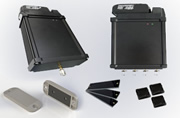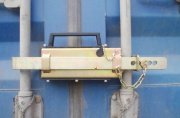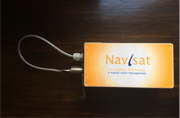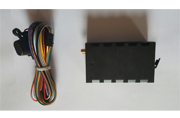RFID Technology
 Radio frequency identification (RFID) describes a system that transmits the identity (in the form of a unique serial number) of an object or person wirelessly, using radio waves. It's grouped under automatic identification technologies.
Radio frequency identification (RFID) describes a system that transmits the identity (in the form of a unique serial number) of an object or person wirelessly, using radio waves. It's grouped under automatic identification technologies.
A typical RFID tag consists of a microchip attached to a radio antenna mounted on a substrate. Antennas read passive tags on cases stacked on a pallet and the information can be retrieved from the tags by RFID readers which pass the information in digital form to a computer system

 -Product is easy to fit -Lock material steel, 6mm thick X 38mm wide -protective cover material-nylon -Maximum supported distance between container bars-345mm -Maximum supported distance between container bars-414mm -Maximum supported container bar diameter-38mm -Weight 2.9kg -Weight with navilock power unit-3.35kg
-Product is easy to fit -Lock material steel, 6mm thick X 38mm wide -protective cover material-nylon -Maximum supported distance between container bars-345mm -Maximum supported distance between container bars-414mm -Maximum supported container bar diameter-38mm -Weight 2.9kg -Weight with navilock power unit-3.35kg -protective cover material-hardened plastic -3-4mm winch cable -GARMIN FMI/Multiple Sensors -Build in 3D motion sensor for power saving and motion detection -Build in GSM antenna -Build in external GPS antenna
-protective cover material-hardened plastic -3-4mm winch cable -GARMIN FMI/Multiple Sensors -Build in 3D motion sensor for power saving and motion detection -Build in GSM antenna -Build in external GPS antenna Wide Operating Voltage Range 8V to 32V DC -Dual Band GSM/GPRS 900/1800 MHz -Multiple I/Os Including 1 Smart Input -GARMIN FMI/Multiple Sensors/Voice Support -Internal Backup Battery -Wide operating voltage range 8 to 32dv DC -Embedded full-featured @ track protocol -GPS standby time without reporting 58hrs,5 mins reporting 33hrs,10mins reporting 45hrs
Wide Operating Voltage Range 8V to 32V DC -Dual Band GSM/GPRS 900/1800 MHz -Multiple I/Os Including 1 Smart Input -GARMIN FMI/Multiple Sensors/Voice Support -Internal Backup Battery -Wide operating voltage range 8 to 32dv DC -Embedded full-featured @ track protocol -GPS standby time without reporting 58hrs,5 mins reporting 33hrs,10mins reporting 45hrs